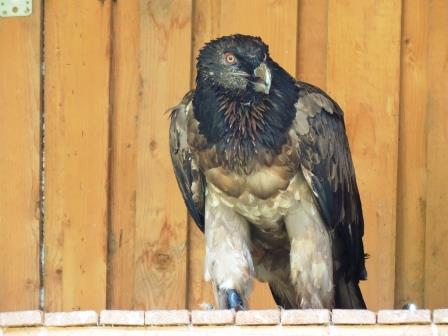
We last caught up with the Alòs and Amic, the two captive-bred bearded vultures released back in May as part of a new reintroduction project in the Maestrazgo region of Spain led by the GVA, back in August.
Flying further afield
As the two young bearded vultures grow in confidence in their flying abilities they have been exploring more and more of their new home and flying further afield. Alòs has traveled around 680km south of the release site to the la Rioja region of Andalusia. This area was the site of the release of Quitèria, a female released back in 2011 who unfortunately died back in 2015.
However, despite traveling separately they often are regularly seen together at the supplementary feeding station.

September update ![]() September report from Maestrazgo bearded vulture reintroduction project (Spanish) Gaceta del Crebalòs N4_Septiembre18 (1). Adobe Acrobat Document 5.8 MB Download
September report from Maestrazgo bearded vulture reintroduction project (Spanish) Gaceta del Crebalòs N4_Septiembre18 (1). Adobe Acrobat Document 5.8 MB Download
Maestrazgo reintroduction project

Historically Spain’s Maestrazgo region has been a breeding site for bearded vultures and is regularly visited by individuals released in Andalusia. Led by the Generalitat of Valencia, in collaboration with the Autonomous Communities from Aragón and Catalonia, the Spanish Ministry of Agriculture, Fish, Food and Environment and us here at the Vulture Conservation Foundation, a reintroduction project started in 2018. The aim of the project is to establish a wild breeding population in the Maestrazgo region to bridge the populations in the Pyrenees and Andalusia.
Guadalentín Specialised Breeding Centre
Alòs and Amic were both captive-bred birds from the Guadalentín Specialised Breeding Centre in Spain. This breeding centre is one of five breeding centres that are part of the Bearded Vulture European Endangered Species Programme – a captive breeding network. Guadalentín is one of the three large breeding centres housing seven breeding pairs of bearded vultures, Cabus and Corba; Elias and Viola; Lázaro and Nava; Joseph and Keno; Andalusia and Salvia; Borosa and Toba; and Tranco and Sabina.
Guadalentín like the other breeding centres are staffed with experts who look after the captive birds who may be wild birds rehabilitated after injury or illness like GypHelp or birds born in the network and kept to breed. Staff at these centres work to provide suitable conditions for breeding for the birds in their care.

This network also includes 35 zoos and two private collections and together looks after 174 birds with the aim of raising bearded vulture chicks that can be released into the wild as part of reintroduction projects we are part of in five different regions of Europe to restore the species to its former range.
Since 1986 300 young birds have been released in the Alps, Cazorla (Andalusia, Spain), Massif Central (France), Corsica (France) and, Maestrazgo which is the newest release project.
Without this network of zoos and breeding centres we would not be able to release young birds like Alòs and Amic into areas where bearded vultures have disappeared.
Bearded Vultures on the Move

As part of our work we urgently need to move 19 bearded vultures across the network to find them new homes and new mates, creating the best conditions for breeding and continue the reintroduction work.
Yesterday we began the transport of three young birds to Guadalentín Specialised Breeding Centre, GypHelp, female BG 911 and male BG 1006 thanks to the generous donations from members of the public.
We are on our last day of public fundraising and have raised 95% of the fund but need your help to meet our target of €7,500 to get all 19 Bearded Vultures on the Move. Head over to our Bearded Vultures on the Move fundraising page, we have just 24 hours left!





